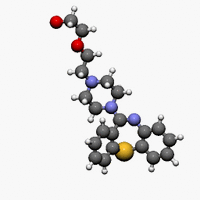Quetiapine
| Quetiapine | |
|---|---|
  The skeletal formula of Quetiapine. | |
| Dosage (oral) | |
| Threshold | 25 mg |
| Light | 25 - 100 mg |
| Common | 75 - 200 mg |
| Strong | 200 - 300 mg |
| Heavy | 300 mg + |
| Duration (oral) | |
| 4 - 8 hours | |
Quetiapine (/kwɨˈtaɪ.əpiːn/ kwi-ty-ə-peen) (branded as Seroquel, Xeroquel, Ketipinor) is a short-acting atypical antipsychotic approved for the treatment of schizophrenia, bipolar disorder, and along with an antidepressant to treat major depressive disorder.
Annual sales are approximately $5.7 billion worldwide, with $2.9 billion in the United States.[1] The U.S. patent,[2] which was set to expire in 2011, received a pediatric exclusivity extension which pushed its expiration to March 26, 2012.[3][4] The patent has already expired in Canada. Quetiapine was developed by AstraZeneca from 1992-1996 as an improvement from first generation antipsychotics. It was first approved by the FDA in 1997. There are now several generic versions of quetiapine, such as Quepin, Syquel and Ketipinor.[5]
Chemistry
Pharmocology
This means Quetiapine is a dopamine, serotonin, and adrenergic antagonist, and a potent antihistamine with clinically negligible anticholinergic properties.[6][7][8][9] Quetiapine binds strongly to serotonin receptors; the drug acts as partial agonist at 5-HT1A receptors.[10] In terms of its antipsychotic effects, the precise mechanism of action is unknown, but according to the dopamine theory of schizophrenia, antipsychotic effects might be related to the drug’s ability to reduce dopaminergic neurotransmission in the mesolimbic pathway.
Subjective effects
Physical effects
The physical effects of Quetiapine can be broken down into 3 components all of which progressively intensify proportional to dosage. These are described below and generally include:
Cognitive effects
The general head space of Quetiapine is often described as one of sleepiness, emptiness, apathy, stupor and zombification. The specific cognitive effects can be broken down into 7 components all of which progressively intensify proportional to dosage. These are described below and generally include:
- Thought deceleration
- Suppression of emotion
- Suppression of information processing
- Suppression of language
- Amnesia
- Ego suppression loss and death
- Suppression of anxiety
Medical uses
- Schizophrenia: There is tentative evidence of the benefit of quetiapine versus placebo in schizophrenia; however, definitive conclusions are not possible due to the high rate of attrition in trials (greater than 50%) and the lack of data on economic outcomes, social functioning, or quality of life.[11]
- Bipolar disorder: In those with bipolar disorder, quetiapine is used to treat depressive episodes, acute manic episodes associated with bipolar I disorder (as either monotherapy or adjunct therapy to lithium, valproate or lamotrigine), and maintenance treatment of bipolar I disorder (as adjunct therapy to lithium or divalproex).[14][15]
- Major depressove disorder: Quetiapine is effective when used by itself[16] and when used along with other medications in major depressive disorder (MDD).[16][17] However, sedation is often an undesirable side effect.[16]
- Other: The use of low doses of quetiapine for insomnia, while common, is not recommended; there is little evidence of benefit and concerns regarding adverse effects.[21][22] It is sometimes used off-label, often as an augmentation agent, to treat conditions such as Tourette syndrome,[23] musical hallucinations[24] and anxiety disorders.[25]
- Parkinsons disease: Quetiapine and clozapine are the most widely used medications for the treatment of Parkinson's disease psychosis due to their very low extrapyramidal side effect liability. Owing to the risks associated with clozapine (e.g. agranulocytosis, diabetes mellitus, etc.), clinicians often attempt treatment with quetiapine first, although the evidence to support quetiapine's use for this indication is significantly weaker than that of clozapine.[26][27]
Toxicity and harm potential
Tolerance and addiction potential
Interactions
Legal issues
References
- ↑ http://drugpatentwatch.com/ultimate/preview/tradename/index.php?query=SEROQUEL
- ↑ http://patft.uspto.gov/netacgi/nph-Parser?Sect1=PTO2&Sect2=HITOFF&p=1&u=%2Fnetahtml%2FPTO%2Fsearch-bool.html&r=1&f=G&l=50&co1=AND&d=PTXT&s1=4,879,288.PN.&OS=PN/4,879,288&RS=PN/4,879,288
- ↑ http://patft.uspto.gov/netacgi/nph-Parser?Sect1=PTO2&Sect2=HITOFF&p=1&u=%2Fnetahtml%2FPTO%2Fsearch-bool.html&r=1&f=G&l=50&co1=AND&d=PTXT&s1=4,879,288.PN.&OS=PN/4,879,288&RS=PN/4,879,288
- ↑ Blockbuster Drugs That Will Go Generic Soon | http://money.usnews.com/money/blogs/the-best-life/2011/04/29/blockbuster-drugs-that-will-go-generic-soon
- ↑ http://www.theodora.com/drugs/quepin_tablets_specifar.html
- ↑ http://www1.astrazeneca-us.com/pi/Seroquel.pdf
- ↑ Binding of antipsychotic drugs to human brain receptors: Focus on newer generation compounds | http://www.sciencedirect.com/science/article/pii/S0024320500009115
- ↑ Neuropsychopharmocology, a fifth generation of progress | http://books.google.co.uk/books?id=BKwkonZwZD0C&pg=PA778&hl=en#v=onepage&q&f=false
- ↑ http://www.drugs.com/pro/seroquel.html
- ↑ Mechanism of Action of Quetiapine | http://psychopharmacologyinstitute.com/antipsychotics/quetiapine/mechanism-of-action/